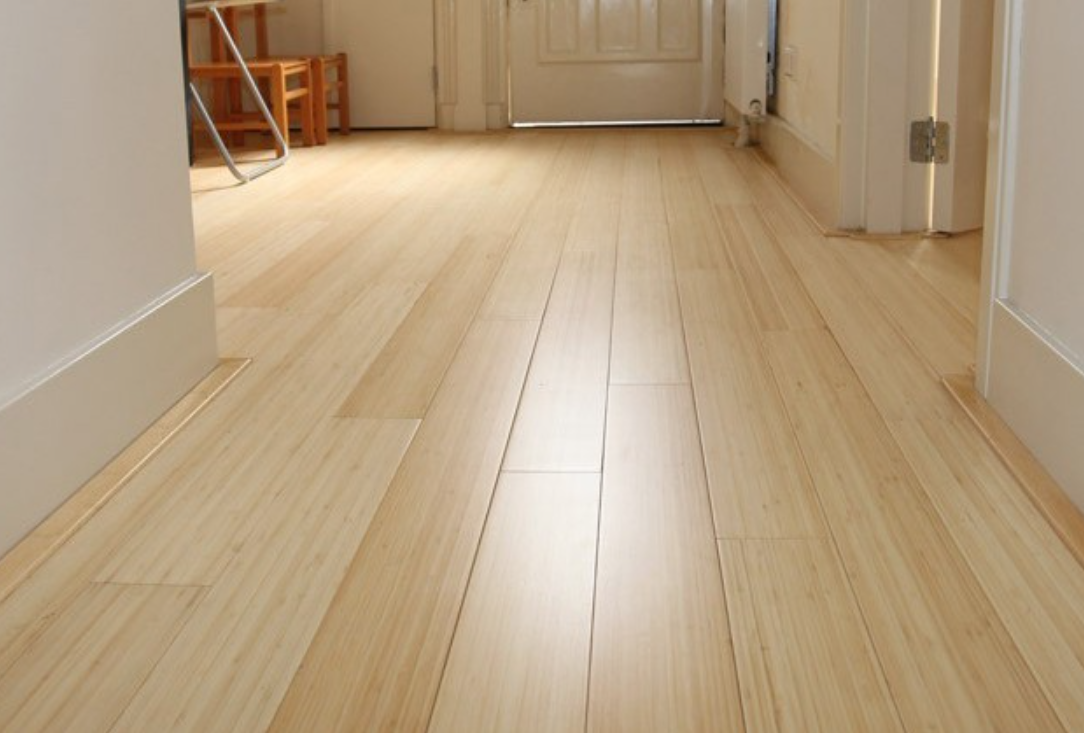Content Framework: Top 4 Faux Wood Flooring Ideas – The Best Alternatives To Real Wood
Picking the right faux wood floor can make your home look amazing. You get the style of real hardwood without the high cost or difficult upkeep. Here are my thoughts on the four best alternatives. I will base my review on price, appearance, durability, and how they work in a real home.
1. Wood-Look Laminate Flooring: Affordable, Durable, and Stylish
I think wood-look laminate is a great choice if you love the beauty of hardwood but not the high price. It is built with a strong fiberboard (HDF) core. A realistic wood-grain picture is layered on top. Then, a tough, scratch-resistant layer protects the plank. It looks very much like real wood and is also extra durable.
Why Choose Laminate? Key Benefits
Budget-Friendly: Laminate costs about 50–75% less than true hardwood. For most people, I feel it’s the best way to get a wood look and stay on budget.
Great Style Choices: I love the number of available styles. You can choose from many wood species. Options range from classic oak to a trendy gray-washed barnwood. You can also find planks with a raised grain or a hand-scraped finish. Some even have distressed surfaces. This helps you match both modern and rustic home styles.
Excellent Durability: The top wear layer resists scratches and pet claws. It also holds up to dents, stains, and fading. I’ve found most products last for many years, even in the busiest homes.
Water Resistance: Many newer laminates are waterproof. I recommend this for kitchens, bathrooms, and basements. Real wood is not a practical choice in these wet areas.
Simple DIY Installation: I suggest laminate for do-it-yourselfers. The planks use a click-lock system. They float over your subfloor, making installation easier. You can also do quick replacements if a single plank gets damaged.
Low Maintenance: You don’t need to wax this flooring or use special cleaners. All you need is regular sweeping and an occasional damp mop.
Performance and Practical Considerations
Noise Reduction: I recommend using a quality underlayment. It will reduce the sound of footsteps. This is very useful in upstairs rooms.
Durability Specs: Most laminate floors are rated AC3 or AC4. This is good for busy households. It can even be used in light commercial spaces.
Fast Installation: Professional crews can install up to 1,000 sq ft per day. Homeowners might progress more slowly based on their experience. Standard plank thickness is between 7 mm and 12 mm. Based on my experience, thicker planks feel more solid under your feet.
2. LVP and LVT Flooring: A Realistic, Durable, and Water-Resistant Choice
I recommend Luxury Vinyl Plank (LVP) and Luxury Vinyl Tile (LVT) if you love the look of wood or stone. They are a practical choice for everyday life.
What Makes LVP and LVT Special?
Authentic Appearance:
LVP comes in long planks that look just like hardwood. The surface has textures and printed films that capture the look of real oak or rich mahogany. LVT is shaped like tiles. I find it’s often used to look like stone or ceramic. Wood-look designs are also available due to sharp, high-definition printing.
Multi-Layer Construction:
Wear layer: Ranges from 8 mil (good for homes) to 22 mil (great for busy commercial spaces). This layer protects against scratches, scuffs, and pet claws.
Design film: This provides a vivid, realistic wood or stone look.
PVC core: It adds toughness, flexibility, and resistance to moisture.
Attached underlayment: (optional) Some planks have this for more comfort and less noise.
Thickness: LVP is usually between 4–8mm thick. LVT can be thinner. Based on my experience, it might need an extra pad for comfort.
Water Resistance & Durability:
Both LVP and LVT are completely water-resistant. I think they are excellent options for kitchens, bathrooms, basements, laundry rooms, and entryways. They handle spills, pet messes, and splashes without any problem.
Design and Versatility
Massive variety: You can pick from a huge selection of wood grains (like oak, hickory, or maple), stone looks, and even unique modern patterns.
Endless layouts: Modern printing makes Vinyl flooring custom layouts possible, like herringbone, chevron, and more.
Fits any décor: In my opinion, you can find an LVP or LVT style to match your home, whether it’s rustic, modern, or classic.
Installation and Other Advantages
DIY-friendly: You can install it yourself. Both kinds use click-lock floating systems or glue-down methods. You can also install LVT with or without grout for a real tile look.
Underfloor heating: You can use both over radiant heat. This adds comfort in cold climates.
Low noise: An optional underlayment pad helps keep footsteps quiet.
Pet-friendly: its scratch and dent resistance holds up well in active households.
3. Wood-Look Tile: The Best Durable Faux Wood Flooring for Wet Areas
Wood-look tile flooring is a top choice. It gives you the elegant look of hardwood without worrying about moisture. Modern porcelain and ceramic tiles look just like real wood. They copy the grain, knots, and colors so well that most people can’t tell them apart.
Key Features & Benefits: Why I Recommend Wood-Look Tile
Very Tough & Water Resistant: I find these tiles are even tougher than hardwood. They resist scratches, dents, and heavy foot traffic. They also handle water without any problems. This makes them great for bathrooms, kitchens, mudrooms, and basements.
Low Maintenance: Cleaning is easy. You just need soap and water. You don’t need to refinish them or buy special products. Stains wipe right off.
Many Styles & Finishes: There are so many options to choose from. You can find tiles in bold stains or with whitewash effects. I’ve seen hand-scraped, distressed, matte, and glossy finishes.
Design Flexibility: These tiles come in planks, rectangles, squares, and chevrons. This allows you to create layouts like herringbone or classic offset patterns. I suggest installing them on floors or walls. They create a great statement in a shower or for a “wood” accent wall by a fireplace.
Safe for Families & Pets: Wood-look tile stands up to pet claws and active kids. It handles everyday wear well and resists warping or scratching.
Popular Styles, Products & Layout Ideas
Leading tiles: Some top choices I recommend include Elisir Royal Castano Chevron and Atlantica Ambar. You should also check out Colonial Wood White, Bora Grey, and Yakarta Negro. I also like Ribbon Maple Ceramic, Birch Wood Matte, and Soft Ash Antimicrobial Porcelain.
Finishes for Any Decor: I think hand-scraped and weathered finishes give a room rustic charm. They pair well with both classic and modern cabinets. Using a grout color that contrasts with the tile can make the pattern stand out.
On-Trend Patterns: For a modern feel, I suggest trying popular patterns like herringbone, chevron, or hexagon. On walls, wood-look mosaics are a popular choice. I find them easier and safer to use than standard wood accent walls.
4. Bamboo Flooring – A Green Alternative to Wood
In my opinion, bamboo flooring is a smart, sustainable choice if you like the look of wood. It’s actually a type of grass that’s ready to harvest in just 3 to 5 years. Most hardwood trees need 20 to 30 years to mature. This fast growth is why I often recommend bamboo to homeowners who want a green alternative to real wood.
How Strong and Hard Is It?
Strand woven bamboo is one of the toughest floors out there. Its Janka hardness rating is over 4,000. To give you an idea, that’s 2 to 3 times harder than oak, which has a rating of about 1,290–1,360.
Even standard bamboo has a Janka rating around 1,300–1,400. This is harder than white oak, walnut, or ash.
Because it’s so hard, bamboo flooring resists dents very well. you won’t see many marks from chair legs, high heels, or heavy foot traffic.
It’s so tough that you’ll almost never need to refinish it in your home.
How It Handles Water and Stains
Bamboo floors handle moisture well. I recommend them for kitchens, entryways, and other busy areas where spills might happen.
You need to make sure it’s sealed correctly. Bamboo can handle some moisture, but standing water can cause damage if the floor isn’t protected.
Green Impact and Style Options
Bamboo grows back very quickly, reaching its full size in a few years. This makes it a great choice for eco-friendly building projects.
The manufacturing process can use a lot of energy. Also, most bamboo is shipped from other countries, which adds to carbon emissions from transport.
You can find bamboo flooring in many styles. It comes in horizontal, vertical, and strand woven types. You can also get different finishes, like natural, carbonized, or stained. I find it easy to match with almost any home style.
The planks come in different widths. You can also choose how to install it: nail-down, glue-down, or floating. This flexibility makes it a good fit for most renovation projects.
For your next project, if you’re looking for a floor that looks like real wood, is very durable, and is good for the environment, I suggest you take a serious look at bamboo.
How to Choose the Right Faux Wood Flooring for Your Home
I’ve walked you through four great faux wood flooring options. With this information, I feel you’re ready to make the right choice for your home. Each material has its own clear advantages. For instance, laminate is a fantastic choice if you’re working with a tight budget. I often suggest luxury vinyl for areas that might get wet because it handles water so well. If you need something truly durable, wood-look tile is incredibly tough. For a choice that is kind to the environment, I recommend bamboo. I suggest you really think about your lifestyle, how much you want to spend, and your long-term plans. The perfect floor that looks beautiful, is practical for your life, and gives you great value is out there.





